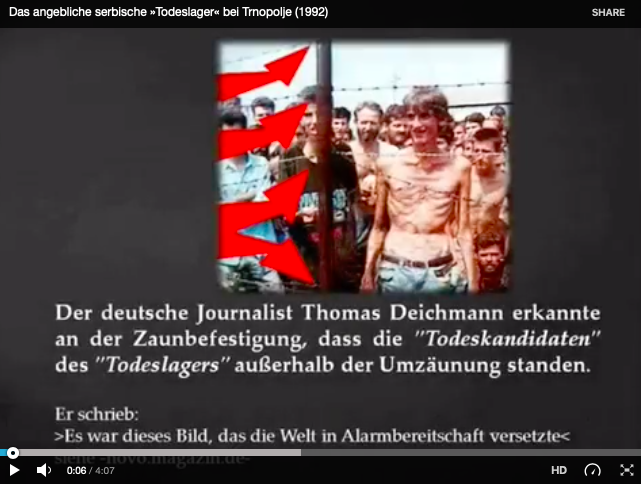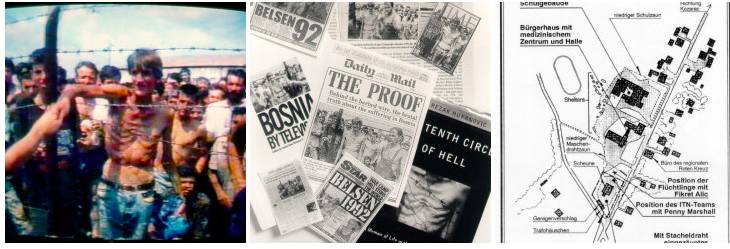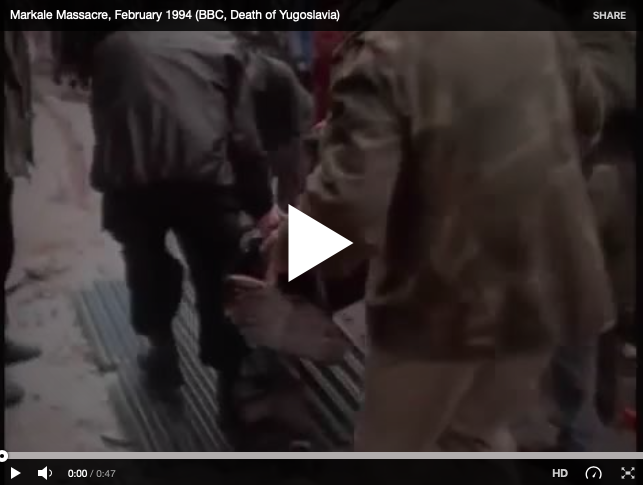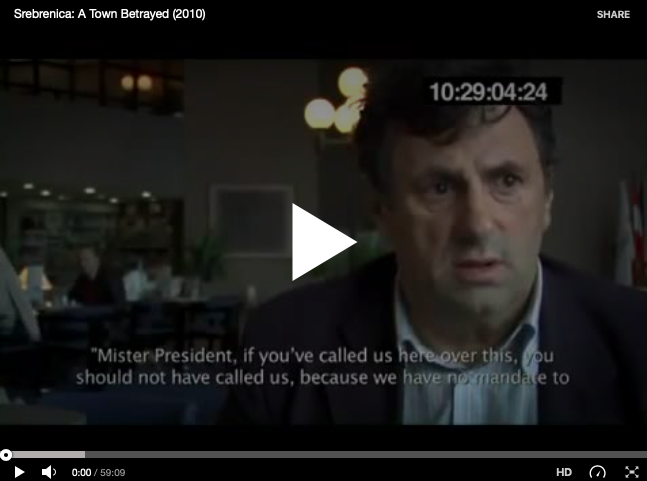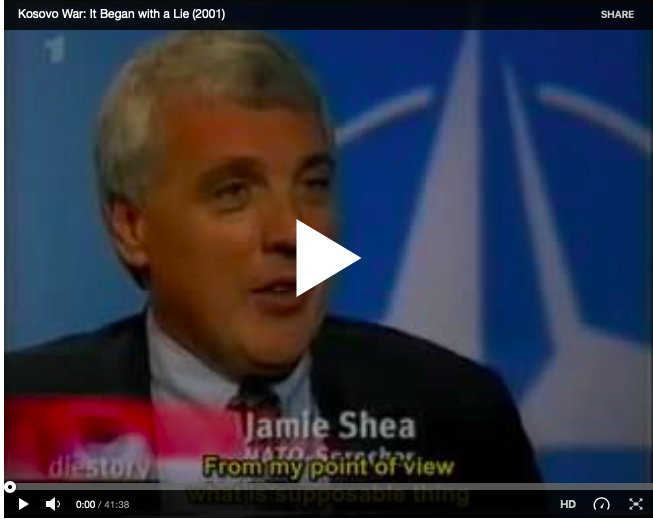Propaganda in the War on Yugoslavia

Updated on December 31, 2019.
From a geopolitical perspective, the war on Yugoslavia in the 1990s was about restructuring South east Europe after the end of the Cold War. To this end, the US even deployed the combatants with which it had previously fought the USSR in Afghanistan and which it would later call “Al Qaeda”.
The political and media propaganda regarding the war on Yugoslavia has been well researched by now. Interestingly, however, many media outlets and commentators are still trying to uphold the official narrative of the time, in contrast to the later war in Iraq, for example.
There may be various reasons for this. On the one hand, the propaganda in question dates back to the early days of the Internet and is therefore generally less well known to the public. On the other hand, the implications, notably for Europe, are particularly far-reaching in this case.
From today’s perspective, it is a rather trivial statement that most Western media outlets supported NATO’s war on Yugoslavia, but at the time even critics believed in a media “failure”, especially because the influence of foreign policy groups on media reporting was not yet broadly known.
The following sections provide an overview of propaganda in the war on Yugoslavia as well as references to further literature and documentation. Please note that the analysis does not call into question regional aspects of the conflict or any actual war crimes on any side of the conflict.
1. The Serbian “Death Camp” (1992)
One of the most notorious cases of propaganda concerns the alleged Serbian “death camp” of Trnopolje in Bosnia. The story began in August 1992, when three British journalists visited a refugee camp whose inmates stressed that they were being treated very well (see video below).
The journalists, however, went inside a fenced-in storage area right next to the refugee camp and filmed the men on the outside through a barbed wire fence, making it appear as if the men were imprisoned, which in fact they were not (see site map below). The journalists then asked a man emaciated from illness or war-related malnutrition to take off his T-shirt.
The resulting photograph – carefully cut to size – landed on the front pages of most Western media as “proof” of Serbian “death camps”, which in turn served as justification for NATO’s subsequent intervention in Bosnia, starting with a no-fly zone.
The Trnopolje death camp deception was exposed by a German journalist in 1997. A British magazine that republished his article got sued by the three British journalists for libel and eventually lost the case because it couldn’t prove their intent.
The head of an American PR agency that had spread the false death camp reports later explained: “We are professionals. We had a job to do and we did it. We are not paid to be moral.”
Full documentary: Yugoslavia: The Pictures that Fooled the World (2000)
The German captions explain how the men being filmed were standing outside of the barbed wire fence and what type of questions the British journalists were asking them.
TV screenshot, press headlines and site map of the Trnopolje refugee camp
2. The Sarajevo Marketplace Massacres (1992-1995)
Another well-known case of propaganda concerns the so-called marketplace massacres during the four-year siege of Sarajevo, in particular the so-called bread line massacre of May 1992 and the two so-called Markale massacres of February 1994 and August 1995.
These incidents allegedly took place by mortar fire from outside of the city and often happened shortly before important political consultations at the UN or EU. They ultimately led to a direct military intervention by NATO – the first in its history – and thus to a turnaround in the Bosnian war.
In the cases mentioned above as well as some others, investigations by officers of the UN protection mission came to the conclusion that these incidents may have been carried out by the Bosnian side itself, perhaps to influence Western public opinion (so-called false flag attacks).
The relevant UN reports, however, were kept secret. Instead, American media — notably CNN — and the US government usually claimed without delay that the respective attack had probably been carried out by the Serbian side (see video below).
Canadian General Lewis MacKenzie, commander of the UN forces in Sarajevo, wrote about the 1992 incident: “Our people told us there were a number of things that didn’t fit. The street had been blocked off just before the incident. Once the crowd was let in and had lined up, the media appeared but kept their distance. The attack took place, and the media were immediately on the scene.”
About the 1994 incident, a BBC journalist noted with surprise how “television crews were on the scene, filming within seconds of the blast”, while UN officers and even doctors were prevented from entering the site, and all of the alleged 197 victims were carried away within 25 minutes. Others pointed out that the market was in fact closed at the time of the incident (see video below).
Regarding the 1995 incident, the London Sunday Times later revealed that British and French UN ammunition experts had concluded the Serbian side was “not guilty”, but they were then “overruled by a senior American officer”, and NATO air strikes began within less than 48 hours.
US professor Yossef Bodansky, the longtime director of the US Congressional Task Force on Terrorism and Unconventional Warfare, later described these incidents as “expertly-staged spectacle of gore” that included the use of “corpses of Bosnian troops recently killed in action”.
In the following you will find the most important articles from that time by journalists who were able to study the unpublished UN reports or talk to officials involved in writing them.
- Bosnia bread queue massacre was propaganda ploy, UN told (Independent, 1992)
- Dateline Yugoslavia: The Partisan Press (Peter Brock, Foreign Policy, 1994, archived)
- Anatomy of a Massacre (David Binder, Foreign Policy, 1994, about Markale I, archived)
- Bosnia’s Bombers (David Binder, The Nation, 1995, about Markale II, archived)
- “Serbs not guilty of massacre” (Hugh McManners, The Sunday Times, 1995, archived)
- Senior official admits to secret U.N. report on Sarajevo massacre (DPA, 1996, archived)
- 2004: Sarajevo massacre remembered (BBC; see quote by General Michael Rose)
Twenty years later, the Bosnian Markale massacres of 1994/95 were recalled when poison gas attacks during the Syrian war turned out to be questionable and the results of UN and OPCW investigations were again suppressed to justify military strikes by NATO countries.
The 1994 Markale massacre (Source: BBC, The Death of Yugoslavia, 1995)
3. The “Genocide of Srebrenica” (1995)
The “Genocide of Srebrenica” in July 1995 is regarded as the sad climax of the Bosnian war. According to Western accounts originally based on a report by the US government, more than 8000 Bosnian civilians may have been killed.
But according to Phillip Corwin, the highest-ranking UN civilian official in Bosnia during the war, the actual evidence points to a more complex situation and a somewhat different context. Corwin calledthe official Western account of events in Srebrenica a “distortion”.
The late political scientist Edward S. Herman and the former CIA officer Robert Baer, who was operating in Yugoslavia during the war, even spoke of a “fraud” in this regard.
For further details, please refer to the following articles and documentaries:
- The Politics of the Srebrenica Massacre (Edward S. Herman, Global Research, 2005)
- Srebrenica Revisited (Diana Johnstone, Counterpunch Magazine, 2005)
- Srebrenica: A Town Betrayed (Norwegian documentary, 60 minutes, 2010)
- The Srebrenica Massacre: Evidence, Context, Politics (Edward S. Herman, ed., 2011)
- Video: Evacuation of Srebrenica refugees (AP, original footage of July 12, 1995)
In general, even events with very high reported victim numbers must sometimes be critically examined. This was shown, for example, by the “Timisoara Massacre” of 1989 with allegedly 4630 dead, which later turned out to be a psychological operation to launch the Romanian revolution.
Srebrenica: A Town Betrayed (Norwegian documentary, 60m, 2010, Wikipedia)
4. Kosovo: “Operation Horseshoe”, Račak and Rogovo, and more (1999)
After the separation of Slovenia, Croatia and Bosnia from Yugoslavia, the US and NATO started another war in 1999 against the remainder of Yugoslavia to additionally separate the province of Kosovo from Serbia. This war again had to be justified by propaganda and disinformation.
In particular, politicians and the media discussed alleged expulsion plans, concentration camps and massacres, which later turned out to be fabricated or questionable. Examples include the alleged “Operation Horseshoe” (to expulse Albanians) and the alleged “Račak massacre”.
In the case of Račak, for instance, Finnish forensic experts concluded that the bodies of KLA fighters killed in action had been moved, redressed, and presented as civilian victims of an execution.
After the war, the head of an American public relations agency that had spread such dubious stories about the situation in Kosovo stated in an interview: “To be honest, when NATO finally attacked in 1999, we opened a bottle of champagne.”
For further details, the German documentary “It Began with a Lie” from 2001 will be shown below (English subtitles available). The documentary shows how Western governments deliberately published false information in order to legitimize the war.
Kosovo War: It Began with a Lie (German documentary, 2001)
*
Note to readers: please click the share buttons above or below. Forward this article to your email lists. Crosspost on your blog site, internet forums. etc.


